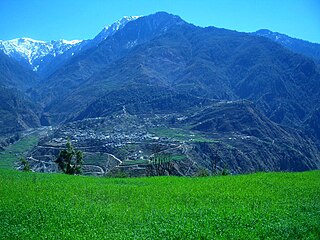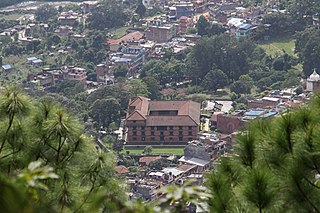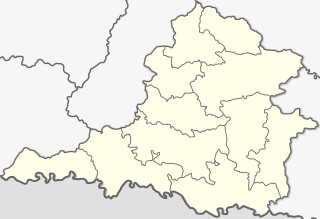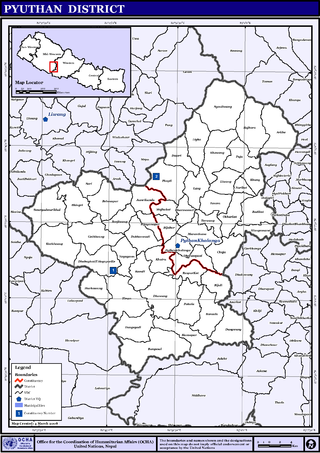
Baglung District, a part of Gandaki Province, is one of the seventy-seven districts of Nepal. The district, with Baglung as its district headquarters, covers an area of 1,784 km2 (689 sq mi) and has a population (2011) of 268,613.

Bajura District, a part of Sudurpashchim Province, is one of the seventy-seven districts of Nepal. The district, with Martadi as its district headquarters, covers an area of 2,188 km2 (845 sq mi) and had a population of 108,781 in 2001 and 134,912 in 2011.

Gorkha District, a part of Gandaki Province, is one of 77 districts of Nepal, and the fourth largest district of the country in terms of area. It is historically linked with the creation of modern Nepal and the name of the legendary Gorkha soldiers. The district, with Gorkha Municipality as its district headquarters, covers an area of 3,610 km2 (1,390 sq mi) and has a population of 252,201, according to the 2021 Nepal census. Gorkha district is the site of the Manakamana Temple, as well as Gorakhnath and Gorakh Kali temples. Several major rivers—including the Chepe, Daraudi, Marsyangdi, Budi Gandaki, and Trishuli—run through the district.

Baglung is a municipality in Gandaki Province, in western Nepal, 275 km (171 mi) west of Kathmandu. It is the administrative headquarters of Baglung District. Baglung serves as the major center for business, finance, education, service and healthcare for the people of mid-Kali Gandaki valley that encompass Beni, Jaljala, Baglung, Kushma, Kathekhola, Galkot, Phalewas and Jaimuni local bodies. The city is located at the cross-section of Kaligandaki corridor highway and midhill highway that transverse Nepal in north–south and east–west directions respectively.

Bandipur is a hilltop settlement and a rural municipality in Tanahun District, Gandaki province of Nepal. Bandipur is primarily known for its preserved, old time cultural atmosphere. At the time of the 2011 Nepal census it had a population of total 15,591 people living in 3,750 individual households.

Waling Municipality, located in the heart of Syangja, is a town and municipality in the western hilly region of [[Nepal]. It was formed on 24 January 1997 by the merging of the then three VDCs namely Waling, Dhanubase and Pekhubaaghkhor. Due to the restructuring of the local government as part of the Federal Government System on 10 March 2017, the municipality's area was expanded to include Majhakot Shiwalaye VDC, Eladi VDC, Jagat Bhanjyang VDC, Chhangchhangdi VDC, Malyangkot VDC, Tindobate VDC, Kalikakot VDC Pelakot VDC ,Thumpokhara VDC(Ward No. 13,14) and Sworek VDC. It is located in the Aadhikhola valley and is bisected by the historic Andhikhola River in Syangja District, Gandaki Province of Nepal. Waling is named the Pink City due to its practice of painting local houses pink. The Government of Nepal has recognized Waling as one of the cities with the potential for future development under the Smart City initiative. Waling received an award for the best municipality of the country and was declared the Clean City of Nepal for The fiscal year 2017.
Kushma is a small village and the headquarter of Parbat District in Nepal. Kushma municipality was formed by merging thirteen village development committees Pang, Khurkot, Durlung, Shivalaya, Chuwa, Katuwa Chaupari, Pipaltari and Pakuwa on 18 May 2014.
Amalachaur is a village development committee in Baglung District in the Dhaulagiri Zone of central Nepal. At the time of the 1991 Nepal census it had a population of 5,055 and had 943 houses.
Burtibang is a village development committee in Baglung District in the Dhaulagiri Zone of central Nepal. Burtibang is the second-largest commercial city in the district after Baglung.

Salyan Village is located in the Bareng Rural Municipality of Baglung District in Nepal. It is located in Gandaki Province. Before 2074 B.S (2017), it was the Salyan V.D.C. Later, it changed the entire area to a single ward, Bareng Rural Municipality Ward No. 4. The total population is 1365, according to the 2021 census, and the area of Salyan is 10.99 km2.
Sarkuwa is a village development committee of the Baglung District of the Dhaulagiri Zone, situated in western Nepal. At the 1991 Nepal census it had a population of 2,516 and 495 houses.

Syaulibang is a village and Village Development Committee in Pyuthan, a Middle Hills district of Rapti Zone, western Nepal.
Dhikurpokhari is a suburb and former Village Development Committee in Kaski District in the Gandaki Province of northern-central Nepal. At the 1991 Nepal census, it had a population of 7,392 persons in 1,427 individual households.
Lunkhu Deurali was a Village Development Committee in Parbat District in the Gandaki Province Nepal. At the time of the 2011 Nepal census it had a population of 2546 people living in 503 individual households.

Kawasoti (Nepali: कावासोती) is a municipality in Nawalpur District, Gandaki Province, Nepal. It is 31 km (19 mi) west of Bharatpur and 85 km (53 mi) east of Butwal, approximately on the middle of Mahendra Highway. The Naryani River flows south of it, and the Mahabharat Range is north of it.
Jaidi is a development committees of Baglung District of Gandaki Province, situated in western Nepal. Jaidi is situated in the southern part of Baglung district. It is surrounded by Chisti, Kiwai, Byarthala, Sarkuwa and Arjewa Village Development Committees. According to the census of 2011. this VDC have more than 1000 households. The VDC is again divided into smaller villages called Ward, and it has 9 different Ward within VDC.
Galkot is a municipality in Baglung district of Gandaki province of Nepal. It consists of several VDCs. Nearby cities include Gulmi and Pokhara. Its geographic coordinates are 28°13'24"N 83°25'29"E.

Paundur (पाउँदुर) is a central village in Kaski district of Gandaki Province of Nepal. It lies about 28 km west of the Pokhara valley and 38 km east of Kushma, Parbat. It is a part of ward no. 3 of Annapurna Gaupalika of Gandaki Province of Nepal, and was the ward no.5 and 8 of the former Dhikurpokhari VDC.It lies west of Nagdanda; nearest sub urban area. There are more than 100 houses in this village.
Jaimini is a municipality in Baglung district of Gandaki province of Nepal. Nearby cities include Kusma and Baglung. Its geographic coordinates are 28.182101" N 83.613602" E. Jaimini Municipality is surrounded by Parbat district on the east, Galkot Municipality and Bareng Rural Municipality on the west, Khathekhola Rural Municipality and Baglung Municipality on the north and Gulmi and Parbat districts on the south. The population of the municipality declined to 24,628 at the 2021 Nepal census. 100% of the residents were Nepali citizens, of which 78.9% were literate.










